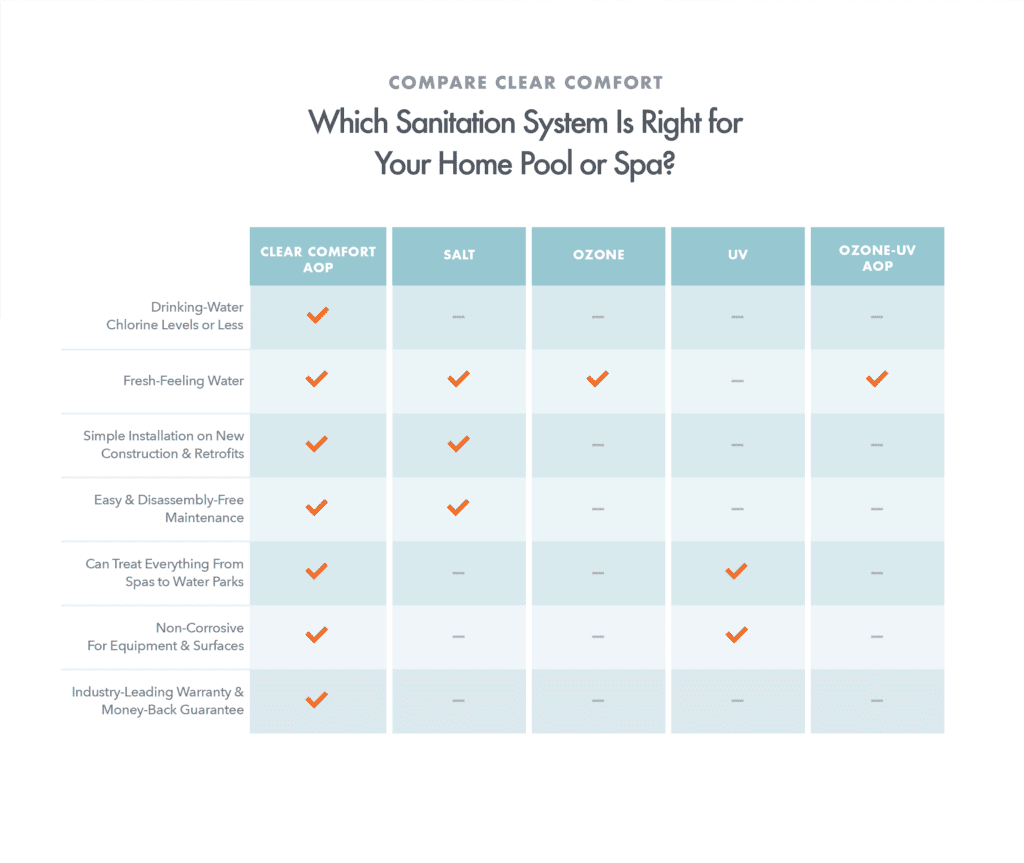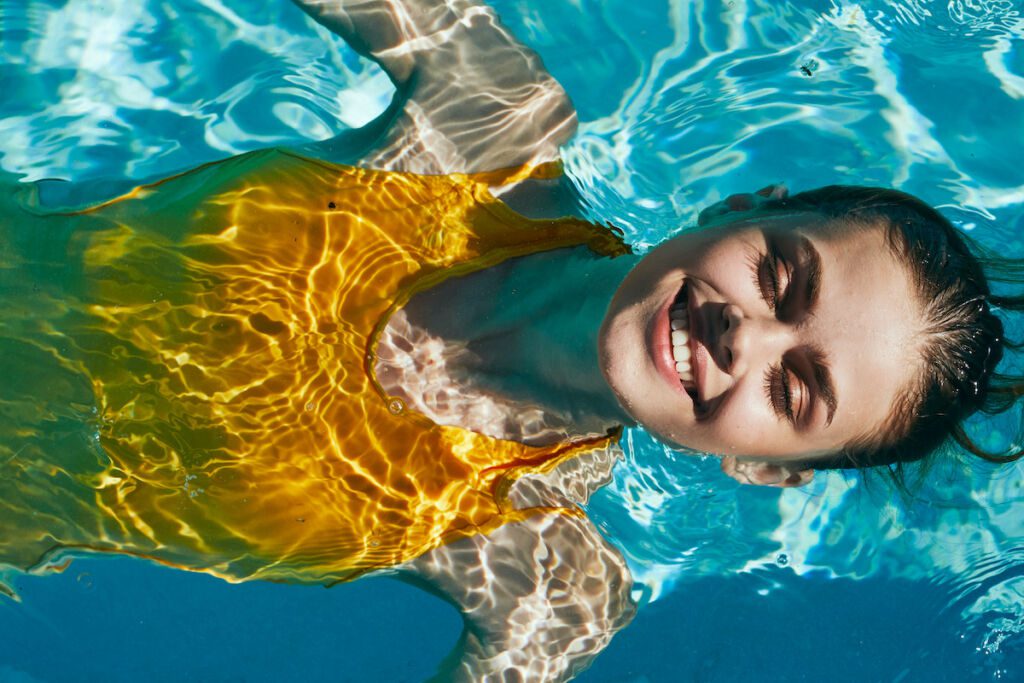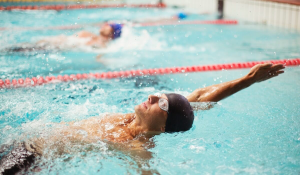We know that sun exposure can harm your skin, but what about exposure to chlorine in swimming pools? Chlorine is a necessity for keeping pool water clean and healthy, but a mismanaged chlorine pool can lead to skin and hair damage.
As kids, it’s unlikely that you questioned why chlorinated swimming pool water gave you red eyes, irritated skin, brittle hair or a chemical odor. In addition to being uncomfortable, these post-swimming symptoms are signs of pool water that can harm your skin, hair and overall health.
So, how does chlorine harm your hair and skin? And what are the best ways to protect your skin and hair from pool chlorine damage? Just a little bit of pool care knowledge (and the right regimes for your skin and hair) can go a long way in avoiding the negative effects of chlorine.
What Pool Chlorine Does to Your Skin and Hair
Before you understand how to protect your skin and hair from chlorine damage, you must know what causes it. Required for aquatic facilities by health codes, chlorine helps to protect swimmers from bacteria, viruses and unwanted contaminants. While chlorine is typically inexpensive to use, recent chlorine shortages have made it more expensive and difficult to find. It is best practice to have a safe amount of chlorine in pool and hot tub water at all times, but mismanaged chlorine levels can wreak havoc on your skin, hair, senses and health.
Many people assume that “pool” odor and irritation are results of chlorine; however, it’s actually combined chlorine (or chloramines), the disinfection by-product (DBP) of chlorine reacting to organic material, like lotion, sweat or perfumes in the water. Our bodies carry this organic material everywhere even when we look or feel clean. When you dive into a swimming pool, the combination of organic materials you introduced with chlorine in the water creates harmful combined chlorine and other DBPs. These DBPs can cause red eyes, asthma, allergies, dry skin, lung irritation, Lifeguard Lung and other health issues.
Swimming in a pool environment with combined chlorine can lead to:
- Dry, flaky and itchy skin irritation
- Brittle hair with split ends and damaged strands
- Dry nails
- Red eyes
- Faded or damaged bathing suits
- “Pool” or “chlorine” odor
- Exacerbated skin conditions, like:
- Psoriasis
- Eczema
- Dermatitis
In short, the more organic materials you introduce to swimming pool water the more potential for combined chlorine creation, which is what mainly causes skin and hair irritation and damage. High amounts of combined chlorine affects both the water in the pool and the air surrounding it. Your skin, eyes, hair, bathing suit and senses can all fall victim to combined chlorine.
Lower Combined Chlorine = Less Irritation to Skin, Hair and Senses
So, if you want to enjoy pool day without detrimental damage to your skin, hair or health, it’s crucial to protect yourself from high combined chlorine levels.
How to Protect Your Skin, Hair and Health from Chlorine
Whether you’re swimming at home, lounging at a hotel pool or getting laps in at the gym, there are proven ways you can prevent and avoid the harmful effects of combined chlorine.
The best and most effective way to avoid combined chlorine is to install or swim at pools with a supplemental or secondary pool sanitation system that lowers the need for chlorine. If swimming at a facility with a supplemental or secondary sanitation system isn’t an option, here are a few ways you can prevent and reduce combined chlorine that introduce the least amount of contaminants into your pool water and help take care of your skin.
Before You Swim:
- Before entering pool water, shower off organics (i.e. sweat, lotions, etc.)
- Ensure pool water chemistry is regularly balance and adjusted
- Go to the bathroom before swimming (and avoid peeing in the pool)
- Use water resistant SPF
- Avoid pets in the pool
After You Swim:
- Immediately after swimming, shower and wash your face to remove any chlorine residue
- Use conditioner that helps defend from the future impact of combined chlorine
- Avoid harsh soaps and shower gels, as they’ll only add insult to injury
- Use a soft towel
- Moisturize your skin after you rinse to prevent irritation
- Apply vitamin C after swimming to neutralize chlorine and chloramines on the skin
- Use a lip balm
- If possible, avoid hair dryers
Bonus tip: Try to avoid swimming in odorous indoor pools with trapped combined chlorine and limited ventilation.
Which Pool Sanitizers Help Protect Your Skin, Hair and Health


Now, let’s talk more about chlorine-alternative sanitation systems. Just like you use sunscreen to protect your skin from the sun, you’ll want to swim with an alternative sanitizer to protect your skin, hair and health. Whether you have your own pool or just simply love swimming, you want to ensure your swimming in water with secondary sanitation. Secondary pool sanitation systems lower the reliance on chlorine and other toxic chemicals needed to disinfect the pool water. While chlorine is a long-standing swimming pool disinfection success story, new technologies have emerged that require minimal amounts of chlorine to be effective which lowers combined chlorine and its irritating effects.
Whether you have your own pool at home or love to swim at aquatic facilities, make sure to swim at pools with secondary sanitation that lower the need for chlorine.
UV Pool Sanitation
One of more well known chlorine-alternatives is UV sanitation systems. UV pool sanitation systems inactivate contaminants by flowing water over a UV, or ultraviolet, lamp in the pool plumbing, but it does not oxidize it. Without oxidation, UV typically needs additional chlorine to destroy contaminants, remove pathogens, and improve clarity or overall water quality. Additionally, research has shown that UV sanitation can increase the rate of free chlorine consumption so while it’s a viable option for secondary sanitation it does not address combined chlorine as well as other systems.
Ozone Pool Sanitation
Ozone pool sanitation systems operate by injecting ozone (O3) gas into the pool plumbing to oxidize and disinfect water. The ozone gas dissolves in the water to kill and oxidize microorganisms, destroy organic compounds and break down chloramines. These types of secondary sanitation systems are effective at addressing combined chlorine but do also come with cons. Since ozone is hazardous, it requires degassing to protect swimmer safety, pool equipment, and surfaces.
Ozone + UV AOP Pool Sanitation
UV+ozone Advanced Oxidation Process (AOP) pool sanitation systems use two technologies to try to boost highly oxidative hydroxyl radicals, while creating ozone in the process. Hydroxyl radicals are the most powerful oxidative compound used in recreational water treatment. UV+ozone systems work by dissolving ozone gas in the water and then passing it through a chamber with a germicidal UV lamp. This process causes a chemical reaction that creates hydroxyls, which oxidize contaminants in the water and then quickly convert back into oxygen.
By combining UV and ozone pool sanitation, the system requires maintenance for both of the two technologies. Maintaining a UV+ozone AOP pool system can take up to 12 hours per year, and requires lamp handling, system disassembly, special tools, annual downtime and professional servicing that’s needed to maintain a UV pool system.
Hydroxyl-Based AOP Pool Sanitation
Hydroxyl-Based AOP pool sanitation systems create the same hydroxyl radicals as UV+ozone AOP pool systems, but at a much faster rate. Rather than combining two systems, Hydroxyl-Based AOP pool treatment pulls in ambient air around the system and treats it with a patented process and directly injects excited atomic oxygen (O1) directly into the pool plumbing to produce high concentrations of hydroxyl radicals. Independent aquatic facility case studies have shown that Hydroxyl-Based AOP pool sanitation systems can reduce DBPs by up to 90 percent successfully addressing the red eyes, irritated skin and brittle hair from combined chlorine.
Hydroxyl-Based AOP Pool sanitation systems not only talk the talk when it comes to reducing combined chlorine, they walk the walk. In a test of performance between a Hydroxyl-Based AOP system and a UV+ozone AOP system, the Hydroxyl-Based AOP sanitation system outperformed its competitor with 2X the oxidative performance. In this test, both systems were installed on a simulated body of water and monitored over a 24 hour period to observe their ability to clear up cloudy water that had been contaminated to mimic bather organic materials that contribute to DBP production. The results of these tests conclusively showed that when it comes to returning water to clear and fresh water without chlorine, Hydroxyl-Based AOP is the clear choice.
It’s time to enjoy long pool days without red eyes, irritated skin, damaged bathing suits and brittle hair. Find a dealer or an aquatics facility today that can start you on the path to the best swimming experience available with the award-winning Clear Comfort Hydroxyl-Based AOP pool sanitation.
To find your local aquatic facilities that use Hydroxyl-Based AOP sanitation, click here.
To find a local dealer that carries Hydroxyl-Based AOP sanitation for your home pool or spa, click here.




